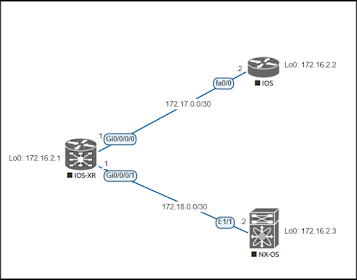1.Remote access should be via SSH and telnet is disabled
IOS-XR:
no telnet ipv4 server
Nexus OS:
no feature telnet
feature ssh
feature tacacs+
JunOS:
delete system services
2. SSH should be version 2 or higher. Do not run v1.
IOS-XR:
ssh server v2
ssh server vrf management
Nexus OS:
ssh server v2
ssh server vrf management
ssh timeout 60
JunOS:
set system services ssh protocol-version v2
3. Configure SSH logging
IOS-XR:
ssh server logging
4. Configure Login Banner
IOS-XR:
banner login ^C
^C
Nexus OS:
banner motd ^
^
JunOS:
set system login message
"\n*************************************************************************\n
UNAUTHORIZED ACCESS TO THIS DEVICE IS PROHIBITED\n\nYou must have
explicit, authorized permission to access or configure this
\ndevice.Unauthorized attempts and actions to access or use this system
may \nresult in civil and/or criminal penalties.\nAll activities
performed on this device are logged and
monitored.\n\n*************************************************************************\n\n"
For more info, pls. refer to this --> https://mynetworkbio.blogspot.com/2020/06/configuring-banner-or-login-message-in.html
5. Configure timestamp, login authentication (exec and session) timeout, ssh only transport input, with ACL configured to allow only authorized IPs and secret password in case tacacs/radius is down
IOS-XR:
line default
secret 5 $1$dAr.$win1P9yOuG1CSvO6v8tAL4
login authentication default
timestamp
exec-timeout 5 0
access-class ingress SSH-ACCESS
session-timeout 5
transport input ssh
ipv4 access-list SSH-ACCESS
10 permit tcp host 192.168.1.100 any eq ssh
20 permit tcp host 192.168.1.101 any eq ssh
30 deny ipv4 any any log
Nexus OS:
interface mgmt0
ip access-group SSH-ACCESS in
vrf member management
ip address 192.168.10.100/24
ip access-list SSH-ACCESS
10 permit tcp 192.168.1.100/32 any eq 22
20 permit tcp 192.168.1.101/32 any eq 22
30 deny ip any any log
line vty
exec-timeout 5
access-class SSH-ACCESS in
6. SSH inactivity timeout should be configured
IOS-XR:
ssh timeout 60
7. Enforce 2FA(2-factor authentication) and configure centralized AAA. Complex password/passphrase should be enforce in Tacacs/Radius Servers.
IOS-XR:
aaa authorization exec default group TACACS group tacacs+ none
aaa authorization commands default group TACACS group tacacs+ none
aaa authorization eventmanager default group tacacs+
aaa authentication login default group TACACS group tacacs+ local
aaa group server tacacs+ TACACS
vrf management
server-private 192.168.1.111 port 49
key 7 143413081E1E0B203F3F213A
Nexus OS:
aaa authentication login default group tacacs
aaa authentication login console group tacacs
aaa authorization config-commands default group tacacs local
aaa authorization commands default group tacacs local
aaa accounting default group tacacs
tacacs+ distribute
ip tacacs source-interface mgmt0
tacacs-server host 192.168.1.111 key 7 "enc_ryptedkey"
tacacs+ commit
JunOS:
set system authentication-order tacplus
set system tacplus-server 192.168.1.111 routing-instance mgmt_junos
set system tacplus-server 192.168.1.111 secret "$9$Gq.5WLGi.56/veLHvYJZjkmTGDLN4oWLXV"
set system tacplus-server 192.168.1.111 timeout 30
set system tacplus-server 192.168.1.111 single-connection
set system tacplus-server 192.168.1.111 source-address 192.168.1.2
set system accounting destination tacplus server 192.168.1.111 secret "$9$-4dHm8XUGiqPQT/9M8Xxb2Z2aZGi.mT"
set system accounting destination tacplus server 192.168.1.111 single-connection
set system accounting destination tacplus server 192.168.1.111 source-address192.168.1.2
For more info, pls. refer to this --> https://mynetworkbio.blogspot.com/2019/08/tacacs-aaa-configuration-in-juniper-and.html
8. Configure control-plane management for SSH if possible
IOS-XR:
control-plane
management-plane
out-of-band
interface MgmtEth0/RP0/CPU0/0
allow SSH peer
address ipv4 192.168.1.100
address ipv4 192.168.1.101
JunOS:
set firewall family inet filter IPv4-PROTECT-RE term SSH from source-prefix-list ALLOWED-IP
set firewall family inet filter IPv4-PROTECT-RE term SSH from protocol tcp
set firewall family inet filter IPv4-PROTECT-RE term SSH from port ssh
set firewall family inet filter IPv4-PROTECT-RE term SSH then count SSH
set firewall family inet filter IPv4-PROTECT-RE term SSH then accept
set policy-options prefix-list ALLOWED-IP 192.168.1.100/32
set policy-options prefix-list ALLOWED-IP 192.168.1.101/32






